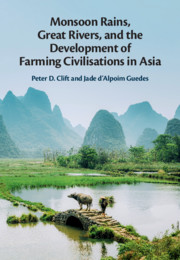Book contents
- Monsoon Rains, Great Rivers, and the Development of Farming Civilizations in Asia
- Monsoon Rains, Great Rivers, and the Development of Farming Civilizations in Asia
- Copyright page
- Contents
- Acknowledgments
- 1 Introduction
- 2 Temporal Variations in the Asian Monsoon
- 3 Monsoon and Societies in Southwest Asia
- 4 Origins of a Uniquely Adaptive Farming System:
- 5 Dryland Farming in the Northern Monsoon Frontier
- 6 Recent Changes in Monsoon Climate
- 7 Future Monsoon Predictions
- References
- Index
6 - Recent Changes in Monsoon Climate
Published online by Cambridge University Press: 17 December 2020
- Monsoon Rains, Great Rivers, and the Development of Farming Civilizations in Asia
- Monsoon Rains, Great Rivers, and the Development of Farming Civilizations in Asia
- Copyright page
- Contents
- Acknowledgments
- 1 Introduction
- 2 Temporal Variations in the Asian Monsoon
- 3 Monsoon and Societies in Southwest Asia
- 4 Origins of a Uniquely Adaptive Farming System:
- 5 Dryland Farming in the Northern Monsoon Frontier
- 6 Recent Changes in Monsoon Climate
- 7 Future Monsoon Predictions
- References
- Index
Summary
The monsoon has changed significantly over the past century. In particular, Northwest India and Pakistan have dried in the latter part of the twentieth century along with northern China. The Indian Peninsula and South China have however become wetter. Some of the aridification is the result of increased aerosol concentrations due to industrialization as well as the southward migration of the Westerly Jet in northern China. The Indus basin is particularly susceptible to drying. Changes in atmosphere circulation have pushed typhoons away from the South China Sea and towards eastern China, although rainfall in South China has strengthened due to locally sourced storms. Dry years in South Asia resulted in significant reductions in the food production. Increased agriculture linked to deforestation has reduced soil moisture and has a negative impact on the climate, especially in Northwest India. Times of drought and poor food production push up prices and have resulted in civil disturbances exacerbated by policies introduced during the Green Revolution. Reduction in biodiversity on farms has reduced resilience to future climate change and caused more harm than changes in the environment over the recent past.
- Type
- Chapter
- Information
- Publisher: Cambridge University PressPrint publication year: 2021

